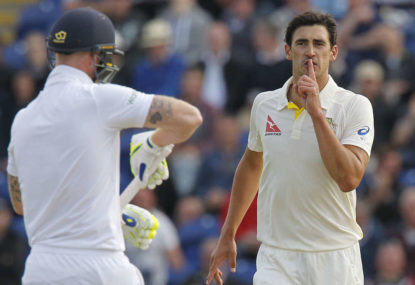Resilience. In 2009, it was the main reason England regained the Ashes.
It’s true that England won at Melbourne in 2010 after losing in Perth, but the Perth loss felt like an aberration. England’s machine had shown an error message, and the techs fixed it at the first opportunity.
It was different in 2009. Australia played some anti-cricket, but were always in the contest. Andrew Flintoff’s absence for the fourth Test at Headingley prompted a bold move from the English selectors; five front-line bowlers. Five. When England were one-nil up in the series.
By the third day at Headingley, England was gone. The first two days were about as one-sided as the recent third Test.
England’s undermanned top six had shown a new-found (and alas temporary) weakness to bowling, and Ravi Bopara need to be replaced. Calls varied, from a desperate plea for the injured Kevin Pietersen, to Mark Ramprakash and Robert Key. All this was on top of the Freddie Hail Mary.
Oh, and some bloke called Jonathan Trott.
In the second innings, Stuart Broad and Graeme Swann were back in their normal positions, James Anderson having been night watchman. The whisper of, “Batsman, batsman,” had been stilled. If they swung with only marginally better footwork than the Statue of Liberty, it didn’t matter.
So they swung. And they hit. Their partnership lasted 12.3 overs. The mid-off and cover boundaries all but bent over and requested an 18th century school headmaster.
Five overs of their partnership went in the following sequence: 16, 16, 16, 10 and 9.
The next over was a five-ball over. Wikipedia says that Test cricket in England between 1889-1899 used five-ball overs. Tailenders also didn’t last very long in that period. During the unintentional five-ball over, Broad’s tailender ancestors told him enough was enough. Understandably not wishing to offend the ghost of Dick Lilley, he honourably holed out off Peter Siddle.
Swann and Steve Harmison provided a bit more entertainment, but didn’t detract from the main story. Australia had levelled the series and looked the goods to retain the Ashes.
Broad was England’s best player in that match. He had taken his first five-wicket haul. At the Oval, he and Swann would rout Australia in the first innings.
Can Mitchell Starc use the Edgbaston match as a springboard in the same way Broad used that Headingley match? Starc bowls left-arm fast, has 72 Test wickets, a bowling average of 32.11, is a bowler of great spells, and bowls balls that would have troubled Sir Donald Bradman in his pomp.
Starc, on the back of his fifth half-century, may have had his confidence lifted by this match. He and Josh Hazlewood have been central to Adam Lyth’s lack of productivity.
However Starc has been too inconsistent thus far in the series. He took five wickets in Cardiff, but it felt as though he had done so by pinching Mitchell Johnson’s luck. Hazlewood has been better, though not by much. The temptation to pick Peter Siddle for Trent Bridge, where he took a five wicket haul in 2013, is large for the Australian selectors.
The problem with Starc and Hazlewood’s inconsistency is that it reduces the advantage Australia has with Johnson and Nathan Lyon in the team. While Starc and Hazlewood leak runs, Johnson and Lyon have to be used more defensively.
Of course, picking on the bowlers after Edgbaston is unfair. It’s like being the teacher who chastises the good student for an error while ignoring the troublemaker’s comparatively much larger error. Michael Clarke was brutal in his self-appraisal after the match. The law of averages suggest he will make at least one significant score in the series. At least now he can look in the mirror and tell his demons that he can’t bat any worse, so shut up.
James Anderson’s enforced absence rids England of their Nottingham specialist, but Mark Wood’s (he of the law of diminishing returns) most recent act as a Test bowler was removing Clarke in the first innings at Lord’s. The old firm of Anderson and Broad have dismissed Clarke only once between them.
It’ll be impossible not to feel for Adam Voges if he doesn’t play at Nottingham. He came in through weight of first-class runs, and he’s a good fielder. However Australia isn’t in the position England is in with Adam Lyth. Shaun Marsh will probably come in. After all, while he might not be the answer to Australia’s problems and it would be unfair to expect the impact Trott had in 2009, he has performed in the tour matches.
Like England in 2009, Australia have shown they are capable of fighting back from a heavy defeat. With sensible changes and a better performance, the series can be leveled in Nottingham. Losing two Tests in a five-match series isn’t a problem if you win the other three. England’s attack won’t turn into bubblebath salesmen without James Anderson. However, England looked unbalanced without Flintoff in 2009. The same is true for England’s attack sans-Anderson. Here’s hoping he’ll be fit enough to take his place at The Oval – it’s never nice seeing a player denied matches through injury.
Australia are teetering right on the edge of the precipice. England are smirking at them. On the lookout, Fleet Street scribbles away. However, Australia can still drag England to the edge by The Oval. In my last article, I said that it was “folly to doubt England’s ability to fight back”.
That applies equally to Australia.






























































































